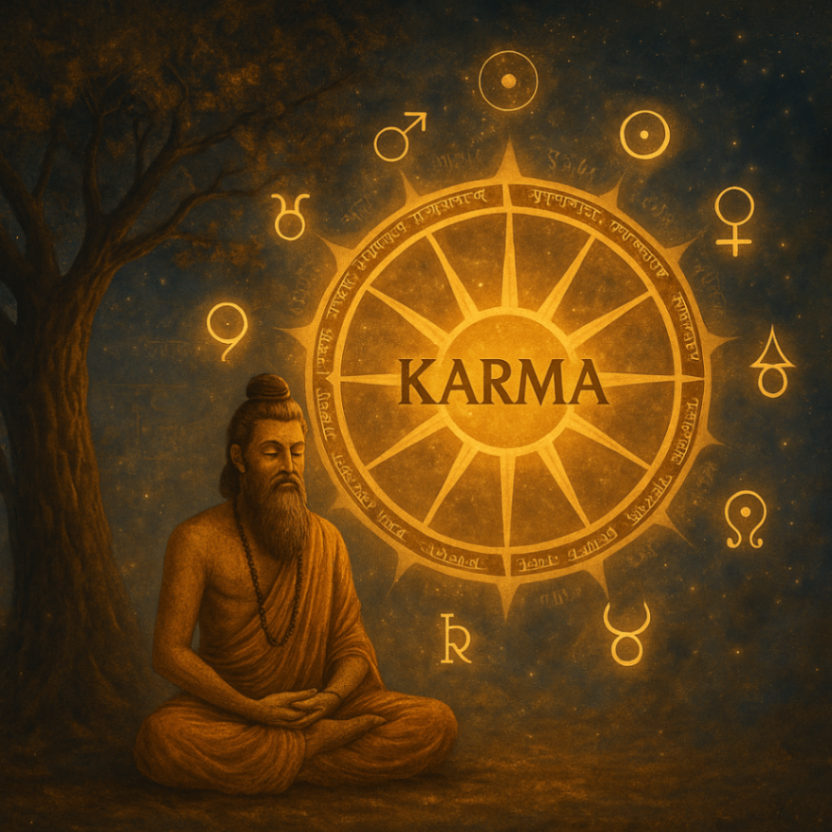Introduction: What is Karma?
In Vedic philosophy, Karma means far more than just “action.” It represents the law of cause and effect, where every deed we perform has a corresponding consequence—if not now, then in the future. This is a fundamental principle in Hinduism and Vedic astrology.
The Bhagavad Gita (18.14) outlines five causes behind every action:
Adhisthana (Body)
Karta (Doer or Soul)
Karana (Organs of Action)
Vividha Cheshta (Various Efforts)
Daivam (Divine Factor or Destiny)

Together, these form the framework of Karma—where both human effort and divine will work hand-in-hand.
Understanding Karma in Daily Life
Let’s take a simple analogy:
If someone plants a mango sapling today, they will get mangoes—not apples. Similarly, our current actions (karma) shape our future outcomes (karma phala). The chain of desire → intention → action → result is how karma unfolds in life.
Astrology and the Role of Destiny
Vedic astrology confirms the power of karma. A skilled astrologer can accurately predict life events from a birth chart alone. This highlights how our past karmas shape the blueprint of our present life—a concept deeply rooted in the science of Jyotish.
Even great souls are not beyond karma.
Lord Rama, destined to be king, was sent into exile. Why? Because his destiny (daivam), as one of the five factors, overruled all human plans.
Four Types of Karma
1. Sanchita Karma (Accumulated Karma)
This includes all karmas from our past lives.
It is stored until the right moment arrives for its effects to unfold.
Cannot be changed, only experienced when the time comes.
2. Prarabdha Karma (Activated Karma)
A portion of Sanchita karma chosen for the current birth.
Determines our birth conditions, challenges, relationships, etc.
Must be exhausted through experiences. Cannot be avoided.
3. Kriyaman Karma (Current Actions)
Actions being done in this lifetime.
These have immediate impact and can change one’s future.
This karma helps in cleaning the karmic balance if done mindfully.
4. Agami Karma (Future Karma)
Actions in the present that will bear fruit in future births.
Formed when intentions remain unfulfilled in this life.
If this isn’t the last life, Agami Karma carries forward.
Akarma and Vikarma: The Spiritual Twist
Akarma (Non-Karma or Detached Action)
It’s not absence of action, but action without attachment.
Performed with no expectation of reward.
A path to liberation (moksha)—the soul acts, but remains free.
Example: A saint serving society without any desire for gain.
Vikarma (Forbidden Action)
These are unethical or harmful actions that lead to negative karma.
Examples include:
Disrespecting parents
Harming society
Cruelty or injustice
Vikarma binds the soul to suffering and rebirth.
Philosophical Influence of the Gunas
Karma is also shaped by the three Gunas (qualities):
Rajas (passion) influences ordinary karma.
Sattva (purity) leads to akarma.
Tamas (ignorance) gives rise to vikarma.
Understanding which guna is active helps in aligning ourselves with higher actions and avoiding karmic traps.
Rahu and Ketu: The Karmic Axis
In Vedic astrology, Rahu and Ketu represent the karmic past and future.
Rahu shows the unfulfilled desires we are drawn toward in this life.
Ketu indicates past-life mastery and where we must develop detachment.
Together, they form the axis of karma in the birth chart. Their position reveals where intense lessons and transformations will occur.
Insight: Rahu in the 10th house may indicate ambition and obsession with career. Ketu in the 4th may point to emotional detachment or a spiritual approach to family life.
Dashas: Timelines of Karma Activation
Dashas (planetary time periods) in Vedic astrology are the clocks of karma.
They show when certain karmas will activate.
A Saturn Dasha might bring responsibility and karmic tests.
A Venus Dasha may highlight relationship karma or material comforts.
These periods reveal how Prarabdha karma unfolds, helping us understand and prepare for life events.
Karma and the Confusion of Action
As said in Bhagavad Gita Chapter 4, Verse 16:
“Even the wise are confused in understanding what is karma and what is akarma.”
This shows that karma is subtle and deep. Sometimes, doing nothing is also an act. Sometimes, doing good with ego still binds us. True karma lies in consciousness, not just physical deeds.
Astrology: A Map of Your Karma
A birth chart is not just about fate—it’s a map of karmic imprints. Vedic astrologers use charts to:
Decode past karmic debts (Rahu-Ketu axis)
See which karmas are active now (Dashas, transits)
Identify opportunities for growth or suffering
By studying your horoscope, you gain awareness—the first step to making better karmic choices.
Spiritual Insight: Destiny is Not Fixed
Although Prarabdha karma cannot be escaped, our Kriyaman karma gives us free will. With wisdom, rituals, mantras, service, and devotion, we can:
Neutralize negative karma
Create positive karma
Progress toward liberation
Astrology, scriptures, and gurus can guide us, but the final decision lies within.
Key Takeaways: The Karmic Blueprint
1. Karma is more than just action—it is the soul’s journey through cause and effect.
2. The five causes of action include both human and divine elements.
3. Karma has four types: Sanchita, Prarabdha, Kriyaman, and Agami.
4. Akarma liberates, Vikarma binds—choice matters.
5. Astrology is a mirror of our karma and helps in understanding life’s challenges.
6. Rahu and Ketu guide us on karmic lessons.
7. Dashas show when karma unfolds.
8. We must use Kriyaman karma wisely to balance our karmic account.
Conclusion
In the cosmic game of life, karma is the rulebook, and astrology is the guide. Each soul carries a unique karmic pattern that unfolds through time and action. But the final empowerment lies with us. By understanding karma through a Vedic lens, we not only decode our destiny but also gain tools to reshape it.















